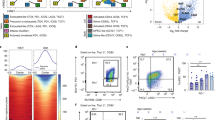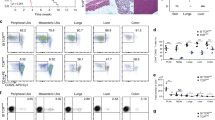Abstract
CD4+ T cells expressing CD40 (Th40 cells) constitute a pathogenic T-cell subset that is necessary and sufficient to transfer autoimmune disease. We have previously demonstrated that CD40 signals peripheral Th40 cells to induce RAG1 and RAG2 expression, proteins necessary for the expression of T-cell receptor (TCR), leading to TCR revision. The dependency of TCR expression in the thymus on RAG proteins has long been known. However, despite numerous publications, there is controversy as to whether TCR expression can be altered in the periphery, post-thymic selective pressures. Therefore, a better understanding of TCR expression in primary peripheral cells is needed. We now show that the CD40 protein itself interacts with RAG1 and RAG2 as well as with Ku70 and translocates to the nucleus in Th40 cells. This indicates that the CD40 molecule is closely involved in the mechanism of TCR expression in the periphery. In addition, Fas signals act as a silencing mechanism for CD40-induced RAGs and prevent CD40 translocation to the nucleus. It will be important to further understand the involvement of CD40 in peripheral TCR expression and how TCR revision impacts auto-antigen recognition in order to effectively target and tolerize autoaggressive T cells in autoimmune disease.
This is a preview of subscription content, access via your institution
Access options
Subscribe to this journal
Receive 12 digital issues and online access to articles
$119.00 per year
only $9.92 per issue
Buy this article
- Purchase on Springer Link
- Instant access to full article PDF
Prices may be subject to local taxes which are calculated during checkout




Similar content being viewed by others
References
Leu TM, Schatz DG . rag-1 and rag-2 are components of a high-molecular-weight complex, and association of rag-2 with this complex is rag-1 dependent. Mol Cell Biol 1995; 15: 5657–5670.
Tonegawa S . Somatic generation of antibody diversity. Nature 1983; 302: 575–581.
McGargill MA, Derbinski JM, Hogquist KA . Receptor editing in developing T cells. Nat Immunol 2000; 1: 336–341.
McMahan CJ, Fink PJ . RAG reexpression and DNA recombination at T cell receptor loci in peripheral CD4+ T cells. Immunity 1998; 9: 637–647.
McMahan CJ, Fink PJ . Receptor revision in peripheral T cells creates a diverse V beta repertoire. J Immunol 2000; 165: 6902–6907.
Serra P, Han B, Yamanouchi J, Thiessen SJ, Santamaria P . RAG-dependent peripheral T cell receptor diversification in CD8+ T lymphocytes. Proc Natl Acad Sci USA 2002; 13: 13.
Vaitaitis GM, Poulin M, Sanderson RJ, Haskins K, Wagner DH Jr . Cutting edge: CD40-induced expression of recombination activating gene (RAG) 1 and RAG2: a mechanism for the generation of autoaggressive T cells in the periphery. J Immunol 2003; 170: 3455–3459.
Zehn D, Bevan MJ, Fink PJ . Cutting edge: TCR revision affects predominantly Foxp3 cells and skews them toward the Th17 lineage. J Immunol 2007; 179: 5653–5657.
Cooper CJ, Orr MT, McMahan CJ . Fink PJ . T cell receptor revision does not solely target recent thymic emigrants. J Immunol 2003; 171: 226–233.
Cooper CJ, Turk GL, Sun M, Farr AG, Fink PJ . Cutting Edge: TCR revision occurs in germinal centers. J Immunol 2004; 173: 6532–6536.
Takase M, Kanagawa EM, Kanagawa O . Age-dependent TCR revision mediated by interaction between alphabeta TCR and self-antigens. J Immunol 2007; 179: 2163–2169.
Fink PJ, McMahan CJ . Lymphocytes rearrange, edit and revise their antigen receptors to be useful yet safe. Immunol Today 2000; 21: 561–566.
Hale JS, Ames KT, Boursalian TE, Fink PJ . Cutting Edge: Rag deletion in peripheral T cells blocks TCR revision. J Immunol 2010; 184: 5964–5968.
Wagner DH Jr . Re-shaping the T cell repertoire: TCR editing and TCR revision for good and for bad. Clin Immunol 2007; 123: 1–6.
Wagner DH Jr, Newell E, Sanderson RJ, Freed JH, Newell MK . Increased expression of CD40 on thymocytes and peripheral T cells in autoimmunity: a mechanism for acquiring changes in the peripheral T cell receptor repertoire. Int J Mol Med 1999; 4: 231–242.
Blish CA, Gallay BJ, Turk GL, Kline KM, Wheat W, Fink PJ . Chronic modulation of the TCR repertoire in the lymphoid periphery. J Immunol 1999; 162: 3131–3140.
Balasa B, Krahl T, Patstone G, Lee J, Tisch R, McDevitt HO et al. CD40 ligand–CD40 interactions are necessary for the initiation of insulitis and diabetes in nonobese diabetic mice. J Immunol 1997; 159: 4620–4627.
Durie FH, Fava RA, Foy TM, Aruffo A, Ledbetter JA, Noelle RJ . Prevention of collagen-induced arthritis with an antibody to gp39, the ligand for CD40. Science 1993; 261: 1328–1330.
Kobata T, Azuma M, Yagita H, Okumura K . Role of costimulatory molecules in autoimmunity. Rev Immunogenet 2000; 2: 74–80.
Munroe ME, Bishop GA . A costimulatory function for T cell CD40. J Immunol 2007; 178: 671–682.
Quezada SA, Eckert M, Adeyi OA, Schned AR, Noelle RJ, Burns CM . Distinct mechanisms of action of anti-CD154 in early versus late treatment of murine lupus nephritis. Arthritis Rheum 2003; 48: 2541–2554.
Toubi E, Shoenfeld Y . The role of CD40–CD154 interactions in autoimmunity and the benefit of disrupting this pathway. Autoimmunity 2004; 37: 457–464.
Vaitaitis GM, Wagner DH Jr . High distribution of CD40 and TRAF2 in Th40 T cell rafts leads to preferential survival of this auto-aggressive population in autoimmunity. PLoS ONE 2008; 3: e2076.
Waid DM, Vaitaitis GM, Wagner DH Jr . Peripheral CD4loCD40+ auto-aggressive T cell expansion during insulin-dependent diabetes mellitus. Eur J Immunol 2004; 34: 1488–1497.
Wang X, Huang W, Mihara M, Sinha J, Davidson A . Mechanism of action of combined short-term CTLA4Ig and anti-CD40 ligand in murine systemic lupus erythematosus. J Immunol 2002; 168: 2046–2053.
Yu S, Medling B, Yagita H, Braley-Mullen H . Characteristics of inflammatory cells in spontaneous autoimmune thyroiditis of NOD.H-2h4 mice. J Autoimmun 2001; 16: 37–46.
Wagner DH Jr, Vaitaitis G, Sanderson R, Poulin M, Dobbs C, Haskins K . Expression of CD40 identifies a unique pathogenic T cell population in type 1 diabetes. Proc Natl Acad Sci USA 2002; 99: 3782–3787.
Waid DM, Vaitaitis GM, Pennock ND, Wagner DH Jr . Disruption of the homeostatic balance between autoaggressive (CD4+CD40+) and regulatory (CD4+CD25+FoxP3+) T cells promotes diabetes. J Leukoc Biol 2008; 84: 431–439.
Waid DM, Wagner RJ, Putnam A, Vaitaitis GM, Pennock ND, Calverley DC et al. A unique T cell subset described as CD4loCD40+ T cells (TCD40) in human type 1 diabetes. Clin Immunol 2007; 124: 138–148.
Hale JS, Wubeshet M, Fink PJ . TCR revision generates functional CD4+ T cells. J Immunol 2010; 185: 6528–6534.
Hillion S, Dueymes M, Youinou P, Jamin C . IL-6 contributes to the expression of RAGs in human mature B cells. J Immunol 2007; 179: 6790–6798.
Heath AW, Wu WW, Howard MC . Monoclonal antibodies to murine CD40 define two distinct functional epitopes. Eur J Immunol 1994; 24: 1828–1834.
Rolink A, Melchers F, Andersson J . The SCID but not the RAG-2 gene product is required for S mu-S epsilon heavy chain class switching. Immunity 1996; 5: 319–330.
Haskins K, Portas M, Bergman B, Lafferty K, Bradley B . Pancreatic islet-specific T-cell clones from nonobese diabetic mice. Proc Natl Acad Sci USA 1989; 86: 8000–8004.
Vaitaitis GM, Wagner DH Jr . CD40 glycoforms and TNF-receptors 1 and 2 in the formation of CD40 receptor(s) in autoimmunity. Mol Immunol 2010; 47: 2303–2313.
Laemmli UK . Cleavage of structural proteins during the assembly of the head of bacteriophage T4. Nature 1970; 227: 680–685.
DiLorenzo TP, Graser RT, Ono T, Christianson GJ, Chapman HD, Roopenian DC et al. Major histocompatibility complex class I-restricted T cells are required for all but the end stages of diabetes development in nonobese diabetic mice and use a prevalent T cell receptor alpha chain gene rearrangement. Proc Natl Acad Sci USA 1998; 95: 12538–12543.
Gellert M . V(D)J recombination: RAG proteins, repair factors, and regulation. Annu Rev Biochem 2002; 71: 101–132.
Morio T, Hanissian SH, Bacharier LB, Teraoka H, Nonoyama S, Seki M et al. Ku in the cytoplasm associates with CD40 in human B cells and translocates into the nucleus following incubation with IL-4 and anti-CD40 mAb. Immunity 1999; 11: 339–348.
Lin-Lee YC, Pham LV, Tamayo AT, Yoshimura LC, Ford RJ . Nuclear localization in the biology of the CD40 receptor in normal and neoplastic human B lymphocytes. J Biol Chem 2006; 281: 18878–18887.
Datta SK . Production of pathogenic antibodies: cognate interactions between autoimmune T and B cells. Lupus 1998; 7: 591–596.
Stadinski BD, Delong T, Reisdorph N, Reisdorph R, Powell RL, Armstrong M et al. Chromogranin A is an autoantigen in type 1 diabetes. Nat Immunol 2010; 11: 225–231.
Hutchings P, Cooke A . Protection from insulin dependent diabetes mellitus afforded by insulin antigens in incomplete Freund's adjuvant depends on route of administration. J Autoimmun 1998; 11: 127–130.
Nakayama M, Babaya N, Miao D, Gianani R, Liu E, Elliott JF et al. Long-term prevention of diabetes and marked suppression of insulin autoantibodies and insulitis in mice lacking native insulin B9-23 sequence. Ann NY Acad Sci 2006; 1079: 122–129.
Crawford F, Stadinskia B, Jina NY, Michelsc A, Nakayamab M, Pratt P et al. Specificity and detection of insulin-reactive CD4+ T cells in type 1 diabetes in the nonobese diabetic (NOD) mouse. Proc Natl Acad Sci USA 2001; 108: 16729–16734.
Skarstrand H, Lernmark A, Vaziri-Sani F . Antigenicity and epitope specificity of ZnT8 autoantibodies in type 1 diabetes. Scand J Immunol 2013; 77: 21–29.
Hawkes CJ, Schloot NC, Marks J, Willemen SJ, Drijfhout JW, Mayer EK et al. T-cell lines reactive to an immunodominant epitope of the tyrosine phosphatase-like autoantigen IA-2 in type 1 diabetes. Diabetes 2000; 49: 356–366.
Abulafia-Lapid R, Elias D, Raz I, Keren-Zur Y, Atlan H, Cohen IR . T cell proliferative responses of type 1 diabetes patients and healthy individuals to human hsp60 and its peptides. J Autoimmun 1999; 12: 121–129.
Baker RL, Wagner DH Jr, Haskins K . CD40 on NOD CD4 T cells contributes to their activation and pathogenicity. J Autoimmun 2008; 31: 385–392.
Acknowledgements
This work was supported by grants from the American Diabetes Association, the Juvenile Diabetes Research Foundation, the Kleberg Foundation and an R01 from NIDDK awarded to DHW. We thank Dr Kathryn Haskins and Dr Rocky Baker, University of Colorado at Denver and National Jewish Health, for generously supplying BDC T-cell clones.
Author information
Authors and Affiliations
Corresponding author
Rights and permissions
About this article
Cite this article
Vaitaitis, G., Wagner, D. CD40 interacts directly with RAG1 and RAG2 in autoaggressive T cells and Fas prevents CD40-induced RAG expression. Cell Mol Immunol 10, 483–489 (2013). https://doi.org/10.1038/cmi.2013.24
Received:
Revised:
Accepted:
Published:
Issue Date:
DOI: https://doi.org/10.1038/cmi.2013.24
Keywords
This article is cited by
-
CD40-targeted peptide proposed for type 1 diabetes therapy lacks relevant binding affinity to its cognate receptor. Reply to Pagni PP, Wolf A, Lo Conte M et al [letter]
Diabetologia (2019)
-
CD40 in coronary artery disease: a matter of macrophages?
Basic Research in Cardiology (2016)
-
Platelets promote allergic asthma through the expression of CD154
Cellular & Molecular Immunology (2015)
-
A CD40-targeted peptide controls and reverses type 1 diabetes in NOD mice
Diabetologia (2014)



